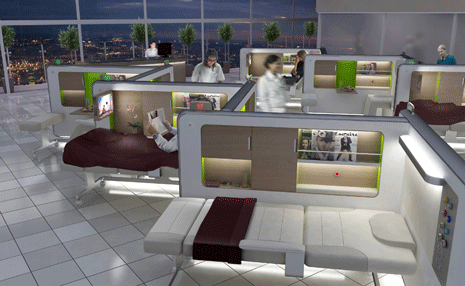
Going to hospital isn’t an experience that many of us relish, even if it’s for a minor operation or just to visit a patient. It seems that a change from the clinical white and impersonal feel that many of us experience as soon as we walk into a hospital as well as the inefficiencies and issues with cleanliness that are often the case with many healthcare systems, would be very much welcomed. In fact, there has been quite a bit of press recently about design in healthcare and how to rethink and improve the role of NHS hospitals and patient care in the UK. A number of organisations including the Design Council has been pushing this issue for quite some time. For instance, it has orchestrated a number of campaigns such as Design Bugs Out that is looking at redesigning hospital equipment and furniture and Design for Patient Dignity that recently commissioned six teams of designers and manufacturers to look at how innovative new designs can solve privacy and dignity issues (think of the standard hospital gown that often exposes the patient’s rear end to all who make walk behind them!).
Priestmangoode, a London-based design consultancy, has identified a compelling opportunity for using design to address some of the specific challenges thrown up by such cases for rethinking healthcare. It believes that intelligent, efficient design has the potential to improve everyday life for millions of people each year. As a result, they have put together a paper – The Health Manifesto: A Smarter Role for Design in Healthcare – that provides a raft of principles, ideas and new thinking. Although not specifically a healthcare design consultancy, this area is something that managing director Paul Priestman feels very strongly about: “I love new challenges and there seems to be a natural progression from the work we’ve done on micro environments such as airline seats and hotel rooms where we are maximising best use of space to healthcare. Hospitals, despite investment in the past decade or so, have still not moved on as much as consumer and leisure environments yet patient expectations have. Using the expertise we have developed from our work in product and environment design, we believe we can make healthcare more efficient, enjoyable to work in and use.”

In the paper, they have documented a particular example – The Priestmangoode Recovery Lounge – that uses the design principles of business airline cabins and budget hotel rooms to take the strain off the queues for hospital beds and improves quality of wellbeing during recovery. In my opinion, this looks far more welcoming than any hospital ward I have ever been in. But I asked Paul Priestman whether patients would be open to such a radical step change in what they have come to expect from hospitals and whether the public sector will buy into it. He had this to say: “I think patients are open to being treated in a space that would be more comfortable and enjoyable to use, and designed to deliver care quickly and efficiently. If a product or service makes sense economically and with efficiency, there is an openness in the public sector to innovation and new ways of caring for patients.”
So, it seems that there is a huge opportunity now to use the smart art of design to great effect in healthcare. Let’s hope that we see more ideas like this from other design agencies.






